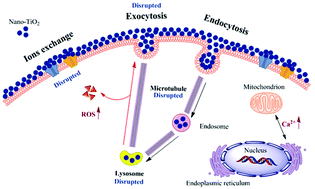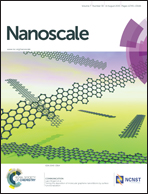Excess titanium dioxide nanoparticles on the cell surface induce cytotoxicity by hindering ion exchange and disrupting exocytosis processes†
Abstract
To date, considerable effort has been devoted to determine the potential toxicity of nanoparticles to cells and organisms. However, determining the mechanism of cytotoxicity induced by different types of nanoparticles remains challenging. Herein, typically low toxicity nanomaterials were used as a model to investigate the mechanism of cytotoxicity induced by low toxicity nanomaterials. We studied the effect of nano-TiO2, nano-Al2O3 and nano-SiO2 deposition films on the ion concentration on a cell-free system simulating the cell membrane. The results showed that the ion concentration of K+, Ca2+, Na+, Mg2+ and SO42− decreased significantly following filtration of the prepared deposition films. More specifically, at a high nano-TiO2 concentration (200 mg L−1) and a long nano-TiO2 deposition time (48 h), the concentration of Na+ decreased from 2958.01 to 2775.72, 2749.86, 2757.36, and 2719.82 mg L−1, respectively, for the four types of nano-TiO2 studied. Likewise, the concentration of SO42− decreased from 38.83 to 35.00, 35.80, 35.40, and 35.27 mg L−1, respectively. The other two kinds of typical low toxicity nanomaterials (nano-Al2O3 and nano-SiO2) have a similar impact on the ion concentration change trend. Adsorption of ions on nanoparticles and the hydrated shell around the ions strongly hindered the ions through the nanoparticle films. The endocytosed nanoparticles could be released from the cells without inducing cytotoxicity. Hindering the ion exchange and disrupting the exocytosis process are the main factors that induce cytotoxicity in the presence of excess nano-TiO2 on the cell surface. The current findings may offer a universal principle for understanding the mechanism of cytotoxicity induced by low toxicity nanomaterials.


 Please wait while we load your content...
Please wait while we load your content...